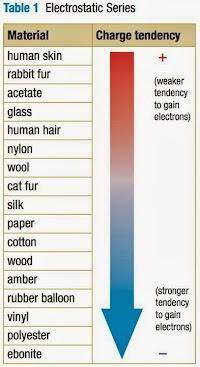
Physics, 13.12.2021 21:10 Billie9166
Which of the following statements about charging by conduction is FALSE? Check all that apply...
- A negatively-charged rabbit fur and positively-charged human skin will result when rubbed together. In contrast, a positively-charged rabbit fur and negatively-charged human hair will result when rubbed together. Note that rubbing a metal pipe with rabbit fur can also transfer electrons, but these electrons will immediately pass through the conductor to the experimenter and then to the Earth.
- In charging by conduction, charging by contact differs from charging by friction where only one physical contact point is needed instead of the entire rubbing surface, the neutral uncharged objects can be either insulators or conductors, one object is already charged instead of beginning with two neutral objects, and both objects have the same charge afterward instead of having opposite charges.
- Charging by contact occurs when a negatively-charged ebonite rod touches a neutral object to remove electrons from the neutral object so that it becomes negatively-charged or occurs when a positively-charged glass rod touches a neutral object to transfer electrons to the neutral object so that it becomes positively-charged.
- Charging by friction occurs when two, different, neutral, solid or liquid, insulators such as silk and wool are rubbed together where silk has a weaker hold on electrons will lose electrons and become positively-charged while wool has a stronger hold on electrons will gain electrons and become negatively-charged.
According to the electrostatic (triboelectric) series, after rubbing their bodies together from greeting each other, the cat fur on the grey kitten becomes positively-charged while the cat fur on the orange kitten is negatively-charged. A neutral rubber balloon suspended from a ceiling by an insulating string will attract the cat fur of the grey kitten, but repel the cat fur of the orange kitten.


Answers: 3


Another question on Physics

Physics, 22.06.2019 00:20
Suppose that an electromagnetic wave which is linearly polarized along the x−axis is propagating in vacuum along the z−axis. the wave is incident on a conductor which is placed at z > 0 region of the space. the conductor has conductivity σ, magnetic permeability µ and electric permittivity ε. (a) find the characteristic time for the free charge density which dissipates at the conductor. (b) write the maxwell equations and derive the wave equation for a plane wave propagating in a conductor. (c) find the attenuation distance at which the incident amplitude reduces to e ^−1 of its initial value. (d) find the electric and magnetic fields inside the conductor. 8 (e) find the power loss per area of the incident electromagnetic wave at the surface of conductor.
Answers: 1

Physics, 22.06.2019 03:00
Isla’s change in velocity is 30 m/s, and hazel has the same change in velocity. which best explains why they would have different accelerations? isla had negative acceleration, and hazel had positive. isla had a different time than hazel. isla had positive acceleration, and hazel had negative. isla went a farther distance than hazel.
Answers: 1

Physics, 22.06.2019 06:00
The magnetic field inside a superconducting solenoid is 4.50 t. the solenoid has an inner diameter of 6.20 cm and a length of 26.0 cm. determine (a) the magnetic energy density in the field and (b) the energy stored in the magnetic field within the solenoid.
Answers: 2

Physics, 22.06.2019 12:30
Apositive charge moves in the direction of an electric field. which of the following statements are true? check all that apply. check all that apply. 1.the potential energy associated with the charge decreases. 2. the electric field does positive work on the charge. 3. the electric field does negative work on the charge. 4. the potential energy associated with the charge increases. 5. the electric field does not do any work on the charge. 6. the amount of work done on the charge cannot be determined without additional information.
Answers: 1
You know the right answer?
Which of the following statements about charging by conduction is FALSE? Check all that apply...
-...
Questions



Computers and Technology, 01.02.2021 22:50




Mathematics, 01.02.2021 22:50





Mathematics, 01.02.2021 22:50

Physics, 01.02.2021 22:50




History, 01.02.2021 22:50


Mathematics, 01.02.2021 22:50

Mathematics, 01.02.2021 22:50



